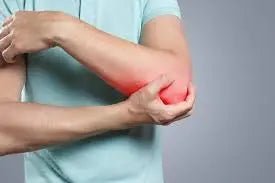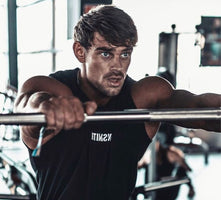
Lifter Elbow: Dealing With Elbow Pain When Lifting Weights
Ever wondered how to fix your elbow pain or what you need to do when facing a burning pain in the elbow? In this article we'll explain the elbow condition that's faced by many people. Get yourself comfortable, this is going to be a long one!
Also known as medial epicondylitis, is a common overuse injury that affects weightlifters and other athletes who engage in repetitive gripping activities. It is characterized when you feel pain and tenderness on the inner side of the elbow, which can radiate down to the forearm and wrist. While the condition is not usually serious, it can be very painful and can interfere with training and daily activities.
Understanding the causes and risk factors is key to preventing and managing the condition. Overuse of the wrist flexor muscles, poor grip strength, and improper technique during weightlifting exercises are common causes. Other risk factors include age, gender, and underlying medical conditions such as arthritis or diabetes. Symptoms can range from mild discomfort to severe pain and weakness in the affected arm.
Key Takeaways
- An injury that affects athletes when weight lifting.
- Understanding the causes and risk factors is key to preventing and managing the condition.
- Symptoms can range from mild discomfort to severe pain and weakness in the affected arm.
Elbow Anatomy
The elbow is a complex hinge joint that connects the upper arm bone (humerus) to the two bones of the forearm (radius and ulna). It allows for flexion and extension of the arm, as well as rotation.
The bones of the elbow are held together by a network of ligaments, which provide stability and prevent excessive movement. The most important ligaments are the ulnar collateral ligament, the radial collateral ligament, and the annular ligament.
The joint is also surrounded by a number of muscles, tendons, and bursae. The muscles of the upper arm (biceps and triceps) attach to the bones via tendons, which allow for movement of the joint. The bursae are small fluid-filled sacs that help to reduce friction between the bones, tendons, and muscles of the joint.
In addition it is innervated by several nerves, including the radial, ulnar, and median nerves. These nerves provide sensation to the skin and muscles of the arm and hand, and also control movement of the joint.
Overall, a thorough understanding of the anatomy is essential for the diagnosis and treatment of elbow injuries.

Causes and Risk Factors for Elbow Pain
A common overuse injury that affects weightlifters and other athletes who engage in repetitive gripping and wrist flexion movements. The condition is characterized by pain and tenderness on the inner side of the elbow, where the tendons of the forearm muscles attach to the bony bump called the medial epicondyle.
The exact cause is not fully understood, but it is believed to be related to repeated microtrauma and inflammation of the tendons that attach to the medial epicondyle. Some of the common risk factors and causes of elbow pain include:
-
Overuse: Often caused by repetitive stress on the tendons of the forearm muscles, which can occur when athletes perform the same movements over and over again without proper rest and recovery. This can lead to the cause of the pain in the posterior elbow.
-
Training errors: Poor technique, improper form when lifting weights in the gym, and incorrect equipment can all contribute to the development of of this type of elbow pain. Athletes who lift weights that are too heavy, perform too many repetitions, or use improper grip techniques are at a higher risk of developing this condition, they are more at risk from facing elbow pain from weightlifting.
-
Excessive loading: It can also be caused by excessive loading of the forearm muscles, which can occur when athletes push/pull weights that are too heavy or perform too many repetitions without proper rest and recovery.
-
Bench press and pressing exercises: Bench press and other pressing exercises that involve gripping and wrist flexion movements are common culprits. These exercises place a lot of stress on the tendons of the forearm muscles and can lead to microtrauma and inflammation over time.
-
Row and deadlift exercises: Row and deadlift exercises that involve gripping and wrist flexion movements can also contribute to the development of the issue. These exercises place a lot of stress on the tendons of the forearm muscles and can lead to microtrauma and inflammation over time.
-
Grip strength: Weak grip strength is a common risk factor, as it can lead to compensatory wrist flexion and gripping movements that place excessive stress on the tendons of the forearm muscles. Athletes who lack grip strength should focus on improving this area through specific exercises and training techniques.
-
False grip and traditional grip: False grip and traditional grip are two common grip techniques that can contribute to the development. False grip involves placing the thumb on top of the barbell or dumbbell, which can place excessive stress on the tendons of the forearm muscles. Traditional grip involves placing the thumb underneath the barbell or dumbbell, which can also lead to excessive stress on the tendons of the forearm muscles.
-
Maximal strength numbers: Athletes who are focused on achieving maximal strength numbers are at a higher risk of developing elbow symptoms, as they may be more likely to push themselves too hard and perform too many repetitions without proper rest and recovery.
Overall, it's complex condition that can be caused by a variety of factors. Athletes who are at risk of developing this condition should focus on proper form and technique, equipment, as well as adequate rest and recovery between training sessions.
Symptoms and Diagnosis for Elbow Pain when Lifting
An injury that often affects weightlifters, powerlifters, and other athletes who engage in repetitive motions that put stress on the joint. The main symptom is pain on the inside part of the elbow, which can range from a dull ache to a sharp, burning sensation. The pain may be aggravated by gripping or lifting heavy objects, and may be accompanied by weakness or tenderness in the affected arm.
In some cases, it may also cause swelling or inflammation around the elbow. This can be a sign of inflammation of the tendons or the bursa, which is a fluid-filled sac that cushions the joint. Swelling may also be a sign of nerve irritation, which can occur when compressed or pinched.
To diagnose properly, a doctor or physical therapist will typically perform a physical exam and ask the patient about their symptoms and medical history. They may also order imaging tests, such as X-rays or an MRI, to rule out other conditions that can cause similar symptoms, such as a fracture or arthritis.
In some cases, a doctor may also perform a nerve conduction study or electromyography (EMG) to evaluate nerve function and determine if there is any nerve damage or irritation. These tests involve placing electrodes on the skin and measuring the electrical activity of the muscles and nerves in the affected arm.
Difference Between Lifter's Elbow & Tennis Elbow
Both are common conditions that is often related to other conditions such as tendinitis, tendinopathy, tendinosis and golfer's elbow. These conditions are all related to the tendons and muscles in the elbow and forearm.
Tendinitis, tendinopathy, and tendinosis are all conditions that involve inflammation or degeneration of the tendons. Tendinitis is an acute condition that involves inflammation, while tendinopathy and tendinosis are chronic conditions that involve degeneration. These conditions can be caused by overuse or repetitive strain, which can occur during weightlifting or other activities that involve gripping or twisting motions.
Both conditions that involve pain and inflammation in the elbow. The tennis variety, also known as lateral epicondylitis, is caused by overuse of the muscles in the forearm that attach to the lateral epicondyle of the elbow. Golfers elbow, also known as medial epicondylitis, is caused by overtraining of the muscles in the forearm that attach to the medial epicondyle of the elbow. Both of these conditions can be caused by weightlifting or other activities that involve gripping or twisting motions.
While these conditions are related, they are not interchangeable. Lifter's elbow specifically refers to pain and inflammation in the elbow that is caused by weightlifting or other activities that involve gripping or twisting motions. However, it is possible for someone with lifters elbow to also have tendinitis, tendinopathy, tendinosis or golfer's elbow.
To summarise
Whilst Lifter's Elbow is known as Medial Epicondylitis, Tennis Elbow is known as Lateral Epicondylitis.
- Cause: A condition caused by overuse or repetitive strain of the forearm extensor muscles and tendons, specifically the extensor carpi radialis brevis muscle and its associated tendons. It is often associated with activities that involve gripping, twisting, or repetitive wrist and forearm movements.
- Symptoms: The primary symptom is pain on the outer side (lateral side) of the elbow. The pain may radiate down the forearm and worsen with gripping or lifting objects.
- Affected Individuals: Tennis players, as well as individuals who engage in activities that require repetitive gripping and wrist movements (e.g., carpenters, painters, gardeners), are at risk of developing the issue.

Impact on Weightlifting Activities
The issue can have a significant impact on weightlifting activities. Elbow pain may lead to discomfort, making it difficult to perform certain exercises. The condition is common among lifters, weightlifters, and powerlifters, as these athletes frequently engage in gripping activities that put a strain on the elbow.
The joint is responsible for rotation, pronation, and supination, which are essential movements during weightlifting activities. These movements allow the lifter to rotate, bend, and straighten their arm, which is necessary for exercises such as the bicep curl. When affected, it can become painful and limit the range of motion, making it difficult to perform these exercises.
It can also affect shoulder stability, as the rotator cuff muscles are connected to the elbow joint. When strained, it can cause the rotator cuff muscles to become weak, leading to shoulder instability. This can make weightlifting activities more challenging and increase the risk of injury.
To prevent , it is essential to maintain proper form during weightlifting activities. This includes using proper alignment and technique, as well as taking breaks when necessary. It is also important to maintain a balanced routine that includes exercises for all muscle groups, not just the arms.
If the issue does occur, there are several treatment options available. Applying heat and taking time to stretch can help alleviate pain and promote healing. Using a brace can also help with support and reduce strain during weightlifting activities. However, it is important to consult with a medical professional before beginning any treatment plan.
Treatment Options & Physical Therapy
When it comes to treating and how to prevent elbow pain there are several options available. The most effective treatment will depend on the severity of the injury and the individual's specific needs.
RICE
RICE stands for Rest, Ice, Compression, and Elevation. One of the most important things to do when experiencing elbow pain is to rest the affected area. This means avoiding any activities that exacerbate the pain, such as lifting weights or performing other strenuous exercises. In addition to rest, applying ice to the affected area can help reduce inflammation and alleviate pain. It is recommended to apply ice for 15-20 minutes at a time, several times a day. Do not continue to lift when facing pain in the elbow.
Braces and Elbow Sleeves
Wearing a brace or elbow sleeve can help support the affected area and reduce pain while lifting. These devices can also help prevent further injury and allow the individual to continue performing light exercises while they recover and allow the ability to lift without pain.

Myofascial Release
Myofascial release is a technique used to release tension in the muscles and fascia surrounding the affected area. This can be done by a trained professional or through self-myofascial release techniques, such as foam rolling or using a massage ball. This can help alleviate pain and improve mobility.
In summary, treament involves a combination of rest, ice, compression, and elevation. Wearing a brace or elbow sleeve can also help support the affected area. Myofascial release techniques can be used to release tension in the muscles and fascia surrounding the affected area. It is important to seek medical attention if the pain persists or worsens.
Prevention and Management for the Lifter
Prevention and management involve a combination of strategies that target the underlying causes of the condition. These strategies include changes to training routines, stretches, and exercises that can help to reduce the risk of developing the condition and training pain free.
Resistance training is a common cause, one way to prevent it is to use a neutral grip when performing exercises like rows and pull-ups. This grip can help to reduce the stress on the tendons and muscles in the forearm and elbow, strengthening exercises such as these can reduce the risk of injury.
Stretching is another effective way of prevention. Incorporating stretches that target the forearm muscles and tendons can help to improve range of motion (ROM) and reduce the risk of soft tissue damage. Some effective stretches include wrist flexor stretches and deep finger and wrist flexor stretches.
Another way to prevent and manage is to make changes to the training routine. This can include reducing the number of reps performed, increasing rest periods between sets, and using lighter weights. These changes can help to reduce the amount of mechanical tension placed on the soft tissues of the elbow, reducing the risk of injury.
In addition to these strategies, it is also important to maintain good blood flow to the affected area. This can be achieved through massage, foam rolling, and other soft tissue mobilization techniques. These techniques can help to improve blood flow to the muscles, tendons, and nerves in the forearm and elbow, reducing the risk of injury.
Finally, it is important to maintain good functional grip strength. Weak grip strength can place additional stress on the forearm muscles and tendons, increasing the risk of injury. Incorporating exercises that target the biceps, triceps, and other muscles in the upper arm and shoulder can help to improve grip strength and reduce the risk.
In summary, prevention and management involves a combination of strategies that target the underlying causes of the condition. These strategies include changes to training routines, stretches, and exercises that can help to reduce the risk of developing the condition. By incorporating these strategies into their training routines, athletes and fitness enthusiasts can reduce the risk of lifter's elbow and improve their overall performance.

FAQ's
What are the symptoms of elbow tendonitis?
Elbow tendonitis, also known as tennis elbow and golfer's elbow, can cause pain and tenderness. The pain may be felt on the outside of the elbow in the case of tennis elbow, or on the inside of the elbow in the case of golfer's elbow. Other symptoms may include stiffness, weakness, and difficulty gripping objects.
How do you treat elbow tendonitis?
Treatment for elbow tendonitis typically involves rest, ice, compression, and elevation. Over-the-counter pain medications such as ibuprofen or acetaminophen may also be recommended to help manage pain and inflammation. Physical therapy and specific exercises may also be prescribed to help strengthen the muscles and tendons in the affected area. Whilst facing muscle pain, avoid exercises that cause pain in the the elbow joint.
What exercises should be avoided with elbow tendonitis?
Exercises that put excessive strain on the elbow joint, such as heavy lifting or repetitive gripping motions, should be avoided with elbow and triceps tendonitis. It is also important to avoid activities that exacerbate the pain and inflammation, as this can delay the healing process and lead to chronic elbow pain.
What is the best way to alleviate inner elbow pain from lifting weights?
One of the best ways to alleviate inner elbow pain from lifting weights is to rest and allow the affected area to heal. Ice, compression, and elevation may also be used to help manage pain and inflammation. Specific exercises may also be prescribed to help strengthen the muscles and tendons in the affected area. This will help you on your elbow recovery journey.
Will lifters elbow go away on its own?
Elbow issues may go away on their own with rest and proper care, but it is important to seek medical attention if the pain and inflammation persist. In some cases, more advanced treatment options such as corticosteroid injections or surgery may be necessary to fully alleviate the symptoms.
Related Posts
- 4 Fantastic Exercises For Lower Back Pain Relief
- Elbow Sleeves, What Are They Good For & Should You Be Using Them?
- Elbow Sleeves vs Elbow Wraps: What Are The Similarities And Differences
- Proper Weightlifting Protection and When to Use
- Hold Fast: 6 Surefire Ways to Increase Grip Strength
- Workout Tips and Accessories That Can Help You Avoid Injuries
- Using Elbow Sleeves and Wraps: Enhance Weightlifting and Powerlifting Performance





